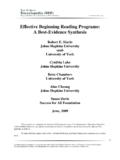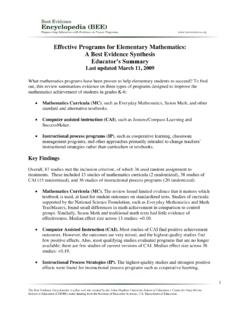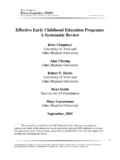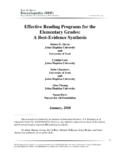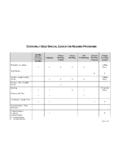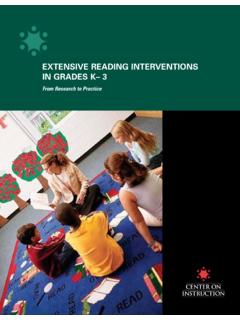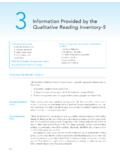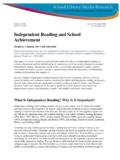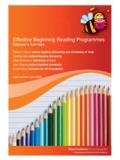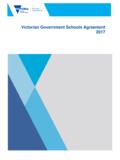Transcription of Effective Reading Programs for Secondary Students
1 Effective Reading Programs for Secondary Students Ariane Baye University of Liege (Belgium) Cynthia Lake Amanda Inns Robert E. Slavin Johns Hopkins University Updated August, 2017 Effective Reading Programs Secondary 2 Abstract Recent initiatives in the and have added greatly to the amount and quality of research on the effectiveness of Secondary Reading Programs , especially Programs for struggling readers. This review of the experimental research on Secondary Reading Programs focuses on 73 studies that used random assignment (n=66) or high-quality quasi-experiments (n=7) to evaluate outcomes of 55 Programs on widely accepted measures of Reading .
2 Specific Programs using one-to-one and small-group tutoring, cooperative learning, and social-emotional approaches showed positive outcomes, as did a small number of Programs emphasizing technology or teaching of metacognitive strategies. Benchmark assessments did not affect Reading outcomes. Leaving aside tutoring and benchmarks, Programs that provide additional time (usually, a daily extra period) were no more Effective than Programs that did not provide instructional time. The findings suggest that Secondary readers benefit more from engaging and personalized instruction than from additional time on supplemental courses.
3 Key words: Secondary Reading Programs , effectiveness studies, best-evidence synthesis, middle school Reading , high school Reading Effective Reading Programs Secondary 3 Effective Reading Programs for Secondary Students The Reading performance of Students in America s middle and high schools is one of the most important problems in education. In 2015, the National Assessment of Educational Progress (NAEP; NCES, 2016) reported that only 34% of eighth graders scored at or above proficient. This is up somewhat from 1992, when 29% of eighth graders scored proficient or advanced.
4 At the twelfth grade level, 37% of Students scored at or above proficient, a slight decrease from 40% in 1992. Despite a substantial focus on Reading at all levels and massive federal, state, and local investments, Secondary Reading is advancing very slowly. According to the OECD Program for International Student Assessment (PISA), the mean performance of American 15-year-old Students did not change between 2000 and 2009, and the proportion of struggling readers also did not change (OECD, 2010). Further, the OECD (2013) survey of adult competencies shows that the average Reading level of American young adults (16-24 year olds) is below the international average for developed countries.
5 Significant gaps continue to exist between groups. While 44% of White eighth graders scored at or above proficient on NAEP, only 16% of African American Students , 21% of Hispanic Students , and 22% of American Indian/Alaska Natives did so (NCES, 2016). Among Students qualifying for free lunch, only 20% scored at or above proficient. At the twelfth grade level, 46% of White twelfth graders scored at proficient or better, but the proportion was 17% for African Americans, 25% for Hispanics, and 28% for American Indian/Alaska Natives. In all of these groups, scores have been essentially static since 1992, the first year NAEP currently reports.
6 The lack of progress in twelfth grade Reading , combined with recent increases in high school graduation rates (from 73% to 82% from 2006 to 2013; NCES, 2016), suggests that the Effective Reading Programs Secondary 4 number of Students graduating from high school with very low Reading levels must be increasing substantially. Students who do not read well in high school are likely to drop out or to graduate without the skills to obtain anything more than menial work (Joftus & Maddox-Dolan, 2003). Poor readers who do graduate are likely to experience serious difficulties entering college.
7 Even if they do go to college, they may be required to take non-credit, remedial English courses (American Diploma Project, 2004; Au, 2000), which many Students do not pass (ACT, 2006). Ideally, Reading success would be assured for all in elementary school. Yet even if improved practices in elementary schools could reduce the numbers of below-level Secondary readers, the numbers are so large that it would be a very long time, if ever, before improved Reading Programs in elementary schools would entirely solve the Secondary Reading problem.
8 Secondary schools will always need strategies to continue to build the Reading skills of their Students . The Need for a New Synthesis of Research on Secondary Reading Programs Several reviews have examined the evidence base for various Programs designed to improve Secondary Reading . In particular, Deshler, Palincsar, Biancarosa, & Nair (2007) summarized evidence on widely-used Programs for adolescent readers, and Slavin, Cheung, Groff, & Lake (2008) reviewed the findings of 33 studies of Secondary Reading Programs that met high methodological standards.
9 Herrera, Truckenmiller, & Foorman (2016), using the methods of the What Works Clearinghouse (2015), found 33 qualifying studies of Secondary Reading Programs , of which 12 found positive effects on Reading outcomes. Wanzek et al. (2013) found ten experimental-control studies that met criteria for their meta-analysis on extensive Reading intervention for Students in grades 4 to 12. Edmonds et al. (2009) identified 17 studies of interventions for struggling readers in grades 6-12 that compared experimental and control Effective Reading Programs Secondary 5 groups, but in seven of these, treatments were delivered by researchers rather than teachers, and the studies involved very small sample sizes, averaging n=65.
10 Dietrichson, B g, Filges, & J rgensen (2017) published a recent review of research on academic interventions for Students with low socioeconomic status. This review overlapped the present review, but it focused on math as well as Reading , and grades K to 8 instead of 6 to 12. Flynn, Zheng, & Swanson (2017) recently reviewed research on Programs for struggling readers in upper elementary and middle schools, reporting on 10 qualifying studies. Scammacca, Roberts, Vaughn, & Stuebing (2015) carried out a meta-analysis of studies of interventions for struggling readers in grades 4-12 published in the period 1980 to 2011, primarily to describe trends over time in interventions, methods, and outcomes.

